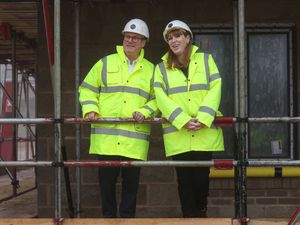Why have changes been made to planning policy and what are they?
The Government said it will intervene if councils do not co-operate fully in a push to deliver 1.7 million new homes.

The Government has made some significant changes to national planning policy in a bid to deliver 370,000 homes a year.
Labour believes the updated national planning policy framework will help them succeed where other governments have failed and provide a much-needed boost to economic growth.
– What is the national planning policy framework?
The national planning policy framework sets out a range of policies reflecting the Government’s approach to planning and development in England, and how these are expected to be implemented.
The framework was first was published in 2012 and the last time it was updated was in December 2023.
The focus has recently been on sustainable development which contributes to economic growth, as well as improving health and protecting the environment.
It has included a requirement for councils to prepare local plans for development that meets the framework’s objectives.
These elements have broadly been retained in the updated document.
The Government launched a consultation on changes to the framework on July 30.
– Why has the Government made changes to the framework?
It is not surprising that a new government wants to change the approach to development, and it is clear Labour believes the framework it inherited would not help deliver the number of new homes required.
The Prime Minister and his deputy Angela Rayner have pledged to build 1.5 million homes and take decisions on 150 major infrastructure projects this parliament – vital elements of the push for economic growth.
The Government now requires an average of 370,000 homes to be approved a year to meet demand.

This would represent a significant increase on recent trends. The last time more than 300,000 were built in a year was when Harold Wilson was prime minister in 1970.
Labour has been promising wholesale changes to process for some time, and the Prime Minister recently insisted he would not “accept the nonsense” of barriers in the planning system.
– What are the main changes in the Government’s approach?
The revised framework re-introduces mandatory targets for councils, amid significant increases in the numbers of new homes expected.
Under a new standardised assessment of need, London is the only region which has a reduced requirement, with the annual target falling from 98,822 to 87,992.
All regions will need to deliver an annual housing approval uplift of above 20%, with the largest rise of 79% required in the North East followed by 61% in the North West.
The Conservatives often talked about intervening when councils failed to produce a plan for local development, but this did not prevent many from doing so.
Under the previous planning framework, just under one-third of local authorities had adopted a local plan within the last five years.
Labour is now talking tough on intervention, vowing to take over local plans if councils fail to comply with their new allotted targets – a bold move to manage numbers on a micro level.
Councils will have 12 weeks from today to ensure their local plans are up to date and comply with the new framework.
Older plans which will still be in place from July 2026 onwards have to be adjusted to show a six-year supply rather than five.
– Where will the new homes be built?
A “brownfield first” strategy remains key to the Government’s approach, with disused sites that have already been developed in the past prioritised for new building and a presumption that applications will be approved.
However, councils will be required to review their greenbelt boundaries by identifying lower quality “greybelt” land that could be built on.

Greybelt land, a term introduced in the Labour manifesto, is greenbelt land that is considered of poor quality or is underused – or as housing minister Matthew Pennycock put it: “land making a limited contribution to the green belt’s purposes.”
– How will local housing plans be put together?
The framework has been updated to ensure a standard method is used for assessing the minimum local housing need.
The previous version included an acknowledgement of “exceptional circumstances” in some areas, which included “particular demographic characteristics”, that enabled some councils to take a different approach.
While the guidance is clear about a requirement for councils to meet local needs, it does recognise that “there may be local constraints on land and delivery that could justify a lower housing requirement figure”.

A paragraph has also been removed from the framework which stated that developments which significantly increase density in urban areas “may be inappropriate” if they are “wholly out of character with the existing area”.
The Government said these concerns should be taken into account during the local process of considering planning applications, adding that retaining the paragraph “could bolster reasons to refuse development that would otherwise be considered sustainable”.
The Government consulted on introducing a “golden rule” of a 50% affordable housing requirement for new homes, but it has decided to provide “flexibility” by allowing councils to set their own mix of tenure – a move it said had “strong support from developers and local authorities.
– Are changes to the framework controversial?
Councils have voiced concerns about the framework’s focus on the number of homes approved rather than delivered and the potential lack of infrastructure.
Richard Wright, planning spokesperson for the District Councils’ Network, said: “A focus on planning consents alone through a standardised method won’t ensure each community’s needs are met.
“Indeed, it could result in poorly-planned developments in locations with poor transport links and inadequate infrastructure that are beset in future by social isolation, and do little to ease the housing shortages experienced by local people.”
While the Government has promised support for councils, there will be concerns over the capacity in planning departments which has depleted significantly over the last decade.
The Government has established a £14.8 million fund, with councils requiring assistance told to express an interest by January 17.
Conservatives have welcomed elements of the plan, but warned that local planning committees will be sidelined, with decisions made by central government, and democratic accountability weakened.
The party has also voiced concern over the future of the green belt and a perceived disproportionate number of new homes required in rural areas.





